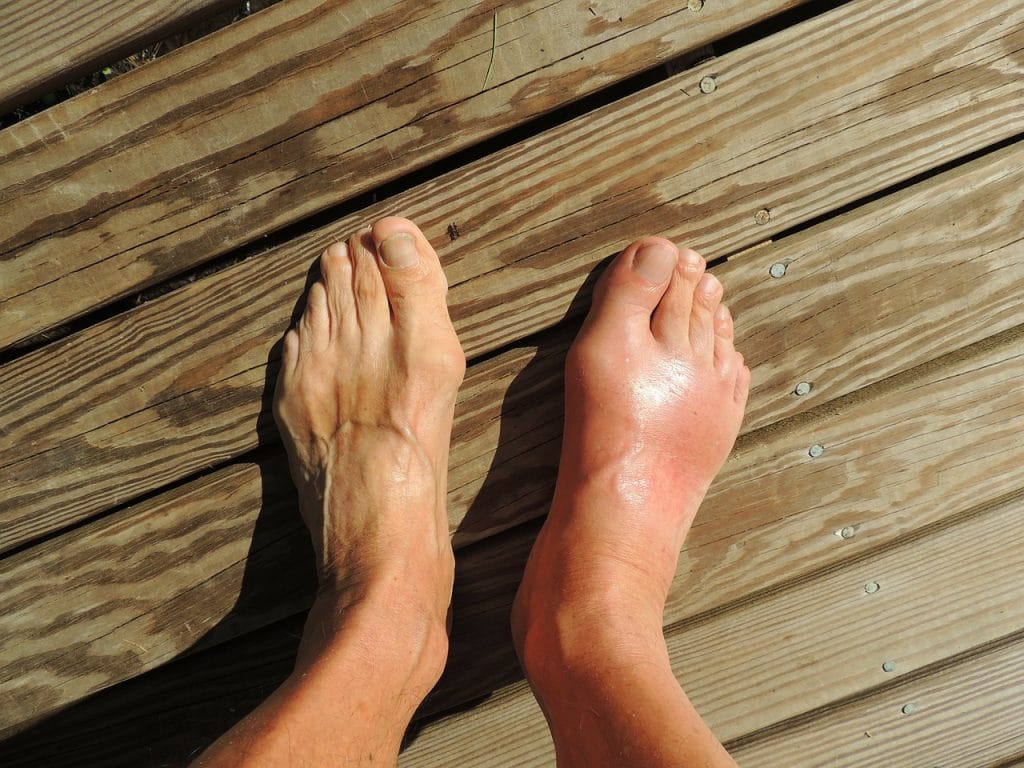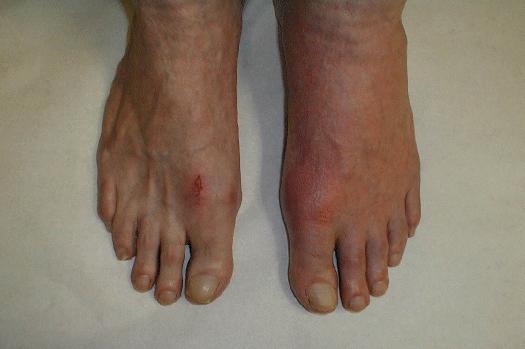
Pictures of Gout in Feet
Looking for pictures of gout in feet? The one above is a fine picture of gout in the right f00t. The majority of gout attacks — between 60-70 percent — occur in the feet and this image is a perfect example of such an attack.
Typical symptoms of a gout flare-up are:
- swelling
- inflammation
- redness
- shiny appearance
The image shows these off to perfection, although there’s also the area being warm to the touch, stiffness, and the agonizing pain which you can’t see!
Here’s another picture showing gout in the feet:

Uric Acid and Gout
The symptoms are caused by microscopic, needle-like crystals of monosodium urate that have been deposited in the joints and surrounding tissue.
The excruciating pain and physical symptoms are a direct result of your body’s acute inflammatory response to the crystals: it floods the joint with white blood cells and inflammatory mediators to resist and eventually expel the intruders.
Uric acid crystals are typically formed when there’s unusually high concentrations of uric acid circulating in the bloodstream — a condition called hyperuricemia. This is usually due either to your body producing too much uric acid (overproduction) or your kidneys’ inability to excrete sufficient excess uric acid (underexcretion).
Either way, uric acid can continue to build up in the bloodstream as long as the condition is ignored.
Uric acid is a natural byproduct of the breakdown of chemical compounds in our bodies and food, called purines. Relatively low blood uric acid is beneficial to health since uric acid acts as a powerful antioxidant helping to neutralize free radicals that can cause damage to cell membranes, proteins, and DNA.
However, when there’s abnormally high levels of uric acid in your bloodstream, this is bad, because uric acid crystals can then form out of the acid and into your joints, triggering your body’s inflammatory response and a gout flare-up.
How to Get Rid of Gout in the Feet
The key is to lower uric acid levels and maintain them at these healthier levels. You can do this through the use of urate-lowering drug-based medications and/or by using complementary and alternative medicine (CAM).
Medications
Inflammation and Pain
Non-steroidal anti-inflammatory drugs (NSAIDs) are generally used to relieve the pain and inflammation of a gout attack. Typical NSAIDs are:
- ibuprofen
- naproxen
- indomethacin
- diclofenac
In those cases where NSAIDs aren’t proving to be effective or the patient can’t tolerate them, then colchicine may be prescribed. And corticosteroids, such as prednisone, can be prescribed where even colchicine is ineffective.
These drugs are only taken during an attack. They are stopped once the symptoms have abated, or according to the doctor’s instructions.
Uric Acid Management
In order to reduce uric acid levels in the blood, urate-lowering drugs such as allopurinol, febuxostat and probenecid are usually prescribed. They are used to first lower, then maintain uric acid at healthy levels.
Urate-lowering drugs can be effective but they have several drawbacks: some nasty side effects and they only work as long as you take them. Once you cease taking them, your uric acid levels can increase again. So, generally speaking, they have to be taken for life.
Remember: NEVER stop taking prescribed medications until your doctor advises you to do so.
Complementary and Alternative Medicine
Complementary and alternative medicine is on the increase as more and more gout sufferers turn away from expensive drug-based solutions with their side effects. These are used for symptom relief as well as uric acid maintenance.
CAM includes things like:
- acupuncture
- acupressure
- ayurveda
- homeopathy
- mineral tissue salts
- hydrotherapy
- herbal medicine
- dietary supplements
- home remedies
But, note that, even with prescribed gout medications doctors generally advise some dietary and lifestyle changes as well.



